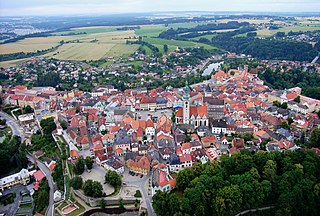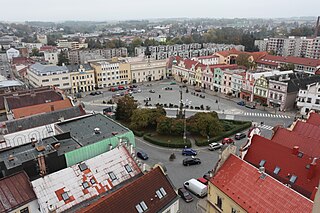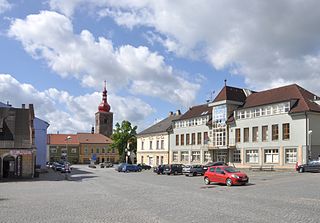
Jihlava is a city in the Czech Republic. It has about 54,000 inhabitants. Jihlava is the capital of the Vysočina Region, situated on the Jihlava River on the historical border between Moravia and Bohemia.

Tábor is a town in the South Bohemian Region of the Czech Republic. It has about 34,000 inhabitants, which makes it the second most populated town in the region. The town was founded by the Hussites in 1420. The historic town centre is well preserved and is protected by law as an urban monument reservation.

Znojmo is a town in the South Moravian Region of the Czech Republic. It has about 34,000 inhabitants. Znojmo is the historical and cultural centre of southwestern Moravia and the second most populated town in the South Moravian Region. The historic centre of Znojmo is well preserved and is protected by law as an urban monument reservation.

Třebíč is a town in the Vysočina Region of the Czech Republic. It has about 35,000 inhabitants.

Havlíčkův Brod is a town in Havlíčkův Brod District in the Vysočina Region of the Czech Republic. It has about 24,000 inhabitants. The historic town centre is well preserved and is protected by law as an urban monument zone.

Nové Město na Moravě is a town in Žďár nad Sázavou District in the Vysočina Region of the Czech Republic. It has about 9,900 inhabitants. It is known as a winter sports resort. The historic town centre is well preserved and is protected by law as an urban monument zone.

Uherský Brod is a town in Uherské Hradiště District in the Zlín Region of the Czech Republic. It has about 16,000 inhabitants. The historic town centre is well preserved and is protected by law as an urban monument zone.

Polná is a town in Jihlava District in the Vysočina Region of the Czech Republic. It has about 5,200 inhabitants. The historic town centre is well preserved and is protected by law as an urban monument zone.

Dačice is a town in Jindřichův Hradec District in the South Bohemian Region of the Czech Republic. It has about 7,200 inhabitants. The historic town centre is well preserved and is protected by law as an urban monument zone.

Pelhřimov is a town in the Vysočina Region of the Czech Republic. It has about 16,000 inhabitants. The historic town centre is well preserved and is protected by law as an urban monument reservation.

Žďár nad Sázavou is a town in the Vysočina Region of the Czech Republic. It has about 21,000 inhabitants. The town is an industrial and tourist centre. It is known for the Pilgrimage Church of Saint John of Nepomuk, which is a UNESCO World Heritage Site.

Jihlava District is a district in the Vysočina Region of the Czech Republic. Its capital is the city of Jihlava.

Brtnice is a town in Jihlava District in the Vysočina Region of the Czech Republic. It has about 3,900 inhabitants. The historic town centre is well preserved and is protected by law as an urban monument zone.

Kelč is a town in Vsetín District in the Zlín Region of the Czech Republic. It has about 2,700 inhabitants. The historic town centre is well preserved and is protected by law as an urban monument zone.

Velké Meziříčí is a town in Žďár nad Sázavou District in the Vysočina Region of the Czech Republic. It has about 12,000 inhabitants. The historic town centre with the castle complex is well preserved and is protected by law as an urban monument zone.

Moravské Budějovice is a town in Třebíč District in the Vysočina Region of the Czech Republic. It has about 7,100 inhabitants. The historic town centre is well preserved and is protected by law as an urban monument zone.

Jemnice is a town in Třebíč District in the Vysočina Region of the Czech Republic. It has about 4,000 inhabitants. The historic town centre is well preserved and is protected by law as an urban monument zone.

Soběslav is a town in Tábor District in the South Bohemian Region of the Czech Republic. It has about 7,100 inhabitants. The historic town centre is well preserved and is protected by law as an urban monument zone.

Počátky is a town in Pelhřimov District in the Vysočina Region of the Czech Republic. It has about 2,500 inhabitants. It is situated on both sides of the historical Bohemian-Moravian border. The historic town centre is well preserved and is protected by law as an urban monument zone.

Přibyslav is a town in Havlíčkův Brod District in the Vysočina Region of the Czech Republic. It has about 4,000 people. The historic town centre is well preserved and is protected by law as an urban monument zone.


































